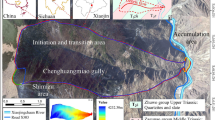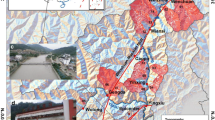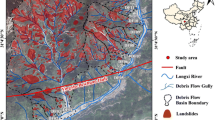Abstract
In the Wenchuan Earthquake area, many co-seismic landslides formed blocking-dams in debris flow channels. This blocking and bursting of landslide dams amplifies the debris flow scale and results in severe catastrophes. The catastrophic debris flow that occurred in Qipan gully (Wenchuan, Southwest China) on July 11, 2013 was caused by intense rainfall and upstream cascading bursting of landslide dams. To gain an understanding of the processes of dam bursting and subsequent debris flow scale amplification effect, we attempted to estimate the bursting debris flow peak discharges along the main gully and analyzed the scale amplification process. The results showed that the antecedent and triggering rainfalls for 11 July debris flow event were 88.0 mm and 21.6 mm, respectively. The event highlights the fact that lower rainfall intensity can trigger debris flows after the earthquake. Calculations of the debris flow peak discharge showed that the peak discharges after the dams-bursting were 1.17–1.69 times greater than the upstream peak discharge. The peak discharge at the gully outlet reached 2553 m3/s which was amplified by 4.76 times in comparison with the initial peak discharge in the upstream. To mitigate debris flow disasters, a new drainage channel with a trapezoidal V-shaped cross section was proposed. The characteristic lengths (h1 and h2) under optimal hydraulic conditions were calculated as 4.50 m and 0.90 m, respectively.
Similar content being viewed by others
References
Chang DS, Zhang LM (2010) Simulation of the erosion process of landslide dams due to overtopping considering variations in soil erodibility along depth. Natural Hazards and Earth System Sciences 10(4): 933–946. DOI: 10.5194/nhess-10-933-2010
Chen HX, Zhang LM, Chang DS, et al. (2012) Mechanisms and runout characteristics of the rainfall triggered debris flow in Xiaojiagou in Sichuan Province, China. Nat Hazards 62: 1037–1057. DOI: 10.1007/s11069-012-0133-5
Chen JG, Chen XQ, Chen HY, et al. (2016) Characteristics of viscous debris flow in a drainage channel with an energy dissipation structure. Journal of Mountain Science 13: 223–233. DOI: 10.1007/s11629-014-3290-z
Chen JG, Chen XQ, Wang T, et al. (2014) Types and causes of debris flow damage to drainage channels in the Wenchuan Earthquake area. Journal of Mountain Science 11: 1406–1419. DOI: 10.1007/s11629-014-3045-x
China Meteorological Administration (2012) Short-term weather forecast quality inspection methods. In: Meteorological and regulations compilation of the PRC. Available online at http://www.cma.gov.cn/2011xzt/2012zhuant/20120928_1_1_1_1/2010052703/201212/t2012 1212_195616.html, accessed on 12 December 2012
Cleary PW, Prakash M (2004) Discrete-element modelling and smoothed particle hydrodynamics: potential in the environmental sciences. Philosophical Transactions of the Royal Society A: Mathematical, Physical and Engineering Sciences 362(1822): 2003–2030.DOI:10.1098/rsta.2004.1428
Costa JE, Schuster RL (1988) Formation and failure of natural dams. Bulletin of the Geological Society of America 100(7): 1054–1068. DOI: 0.1016/0148-9062(89)90825-5
Cui P, Chen X, Zhu Y, et al. (2011a) The Wenchuan earthquake (May 12, 2008), Sichuan Province, China, and resulting geohazards. Nat Hazards 56: 19–36. DOI: 10.1007/s11069-009-9392-1
Cui P, Gordon GD, Zhou XH, et al. (2013) Scale amplification of natural debris flows caused by cascading landslide dam failures. Geomorphology 182: 173–189. DOI: 10.1016/j.geomorph.2012.11.009
Cui P, Hu KH, Zhuang JQ, et al. (2011b) Prediction of debrisflow danger area by combining hydrological and inundation simulation methods. Journal of Mountain Science 8: 1–9. DOI: 10.1007/s11629-011-2040-8
Cui P, Zhuang JQ, Chen XC, et al. (2010) Characteristics and Countermeasures of Debris Flow in Wenchuan Area the Earthquake. Journal of Sichuan University (Engineering Science Edition) 42: 10–19. (InChinese)
Fei XJ, Shu AP (2004) Movement Mechanism and Disaster Control for Debris Flow. Beijing: Tsinghua University Press. (InChinese)
Faccini F, Piccazzo M, Robbiano A (2009) Natural hazards in San Fruttuoso of Camogli (Portofino Park, Italy): a case study of a debris flow in a coastal environment. Italian Journal of Geosciences 128(3):641–654.DOI:10.3301/IJG.2009.128.3.641
Ge YG, Cui P, Zhang JQ, et al. (2015) Catastrophic debris flows on July 10th 2013 along the Min River in areas seriously-hit by the Wenchuan Earthquake. Journal of Mountain Science 12: 186–206. DOI: 10.1007/s11629-014-3100-7
Guo XJ, Cui P, Li Y, et al. (2016a) The formation and development of debris flows in large watersheds after the 2008 Wenchuan Earthquake. Landslides 13: 25–37. DOI 10.1007/s10346-014-0541-6
Guo XJ, Cui P, Li Y, et al. (2016b) Intensity-duration threshold of rainfall-triggered debris flows in the Wenchuan Earthquake affected area, China. Geomorphology 253: 208–216. DOI: 10.1016/j.geomorph.2015.10.009
Guo XJ, Cui P, Li Y, et al. (2016c) Temporal differentiation of rainfall thresholds for debris flows in Wenchuan earthquake affected areas. Environmental Earth Sciences 75(2): 109–121. DOI: 10.1007/s12665-015-5031-1
Hu KH, Ge YG, Cui P (2010) Preliminary Analysis of Extralarge-scale Debris Flow Disaster in Zhouqu County of Gansu Province. Journal of Mountain Science 28: 628–634. (InChinese)
Iverson RM (1997) The physics of debris flows. Reviews of Geophysics 35(3): 245–296. DOI: 10.1029/97RG00426
Kang ZC, Li ZF, Luo JT (2004) Research on debris flow in China. Beijing: Science Press. (InChinese)
Korup O (2005) Geomorphic hazard assessment of landslide dams in South Westland, New Zealand: fundamental problems and approaches. Geomorphology 66(1-4 SPEC. ISS): 167–188. DOI: 10.1016/j.geomorph.2004.09.013
Korup O, McSaveney MJ, Davies TRH (2004) Sediment generation and delivery from large historic landslides in the Southern Alps, New Zealand. Geomorphology 61(1–2): 189–207. DOI: 10.1016/j.geomorph.2004.01.001
Liu JF, You Y, Chen XQ, et al. (2014) Characteristics and hazard prediction of large-scale debris flow of Xiaojia Gully in Yingxiu Town, Sichuan Province, China. Engineering Geology 180: 55–67. DOI: 10.1016/j.enggeo.2014.03.017
Ma C, Hu KH, Tian M (2013) Comparison of debris-flow volume and activity under different formation conditions. Nat Hazards 67: 261–273. DOI: 10.1007/s11069-013-0557-6
Tan WP (1996) Basic theory and study situation of rainstorm debris flow forecast in China. Journal of Soil and Water Conservation 2: 88–95. (InChinese)
Tang C, Jiang ZL, Li W (2015) Seismic landslide evolution and debris flow development: a case study in the Hongchun Catchment, Wenchuan area of China. In Engineering Geology for Society and Territory–Volume 2 (pp 445-449). Springer International Publishing Switzerland. DOI: 10.1007/978-3-319-09057-3_72
Tang C, Liang JT (2008) Characteristics of debris flow in Beichuan Epicenter of the Wenchuan earthquake triggered by rainstorm on September 24, 2008. Journal of Engineering Geology 16: 751–758. (InChinese)
Tang C, Zhu J, Ding J, et al. (2011) Catastrophic debris flows triggered by a 14 August 2010 rainfall at the epicentre of the Wenchuan earthquake. Landslides 8: 485–497. DOI: 10.1007/s10346-011-0269-5
Tang C, Zhu J, Li W, et al. (2009) Rainfall-triggered debris flows following the Wenchuan earthquake. Bulletin of Engineering Geology and the Environment 68: 187–194. DOI: 10.1007/s10064-009-0201-6
Xu ZX (1985) The prevention and control of debris flow of Qipan gully in Wenchuan County, Sichuan Province. Mountain Research 3: 166–172. (InChinese)
Walder JS, O’Connor JE (1997) Methods for predicting peak discharge of floods caused by failure of natural and constructed earthen dams. Water Resources Research 33(10): 2337–2348. DOI: 10.1029/97WR01616
You Y, Liu JF, Chen XC (2010) Debris flow and its characteristics of Subao River in Beichuan County after “5.12” Wenchuan Earthquake. Journal of Mountain Science 28: 358–366. (InChinese)
You Y, Pan HL, Liu JF, et al. (2011) The Optimal Cross-section Design of the “Trapezoid-V” Shaped Drainage Canal of Viscous Debris Flow. Journal of Mountain Science 8: 103–107. DOI: 10.1007/s11629-011-1023-0
Yu B, Ma Y, Wu YF (2013) Case study of a giant debris flow in the Wenjia Gully, Sichuan Province, China. Natural Hazards 65: 835–849. DOI: 10.1007/s11069-012-0395-y
Zhang S, Zhang LM, Chen HX, et al. (2013) Changes in runout distances of debris flows over time in the Wenchuan earthquake zone. Journal of Mountain Science 10: 281–292. DOI: 10.1007/s11629-012-2506-y
Zhou BF, Li DJ, Luo DF (1991) Guide to Prevention of Debris Flow. Beijing: Science Press. (InChinese)
Zhou RJ, Pu XH, He YL, et al. (2000) Recent activity of Minjiang fault zone, uplift of Minshan block and their relationship with seismicity of Sichuan. Seismology and Geology 22: 285–294. (InChinese)
Zhou HJ, Wang X, Yuan Y (2015) Risk assessment of disaster chain: experience from Wenchuan Earthquake-induced landslides in China. Journal of Mountain Science 12: 1169–1180. DOI: 10.1007/s11629-015-3453-6
Zhu XH, Cui P, Zhou GD, et al. (2013) Research on the mechanism of failure and sediment delivery of landslide dams in debris flow channel. In Earthquake-Induced Landslides (pp. 907-915). Springer-Verlag Berlin Heidelberg. DOI: 10.1007/978-3-642-32238-9_99
Acknowledgement
This research was financially supported by the National Natural Science Foundation of China (Grant No.41572302) and the Funds for Creative Research Groups of China (Grant No. 41521002).
Author information
Authors and Affiliations
Corresponding author
Additional information
http://orcid.org/0000-0001-7015-3625
http://orcid.org/0000-0003-2560-4962
Rights and permissions
About this article
Cite this article
Hu, T., Huang, Rq. A catastrophic debris flow in the Wenchuan Earthquake area, July 2013: characteristics, formation, and risk reduction. J. Mt. Sci. 14, 15–30 (2017). https://doi.org/10.1007/s11629-016-3965-8
Received:
Revised:
Accepted:
Published:
Issue Date:
DOI: https://doi.org/10.1007/s11629-016-3965-8




